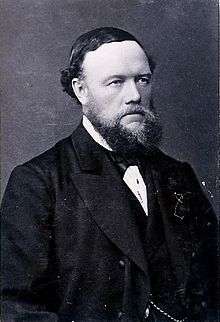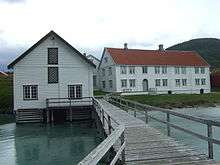Erasmus Zahl
Erasmus Benedicter (Benedigt) Kjerschow (Kjerskov) Zahl (19 January 1826 – 29 April 1900) was a privileged trader and an island owner at Kjerringøy in Nordland, Norway. Zahl is known as Nobel Literature Prize laureate Knut Hamsun's monetary supporter, and a representative of the old, traditional Nordland—Hamsun's ideal society. He is also internationally known through the character Mack, who appears in several works of Hamsun, among them Pan (1894), Dreamers (1904), and Benoni and Rosa (1908).[1]

Photographer: Mr Finne

Photographer: Harald Groven
History
Tradesman's son in Nordvika
Erasmus Zahl was born in 1826 in Nordvika in Dønna, where his father Hans Hansen Zahl was a tradesman. His paternal grandparents were tradesman Hans Olsen Zahl and Anne Margrethe, née Zahl in Nordvika. His mother was Anne Sophie Samuelsdatter Budde, a daughter of priest Lord Samuel Jensen Budde and Nicoline Marie Nicolaisdatter Tombsen.
Tradesman in Kjerringøy
In 1840–50, Erasmus Zahl came to Kjerringøy, where he met and married tradesman Jens Nicolai Ellingsen's widow, Anna Elisabeth née Sverdrup. Thereby, he became the owner of Kjerringøy. It was during Zahl's time in Kjerringøy that the trade seat reached its ultimate wealth. Many economically good years, hereunder the herring fishery between 1865 and 1876, led to Zahl increasing his fortune with 156,000 speciedaler to 265,000 speciedaler.
Anna Ellingsen Zahl died in 1879, after she, at the age of 78 years, fell down one of the main building's stairs. As a widower, Zahl introduced several changes at the trade seat. All sale of alcohol was ended, and nor should alcohol be enjoyed together with meals. Zahl let today's church in Kjerringøy be built, finished in 1883.
Erasmus Zahl died in 1900 of apoplectic stroke. He had no children.
Mack
In the late 1800s, Erasmus Zahl gave monetary support to Knut Hamsun as a young and poor author. Later, 1920 Nobel Literature Prize laureate Hamsun used Zahl as a model for the character Mack appearing in many of his novels, among others Pan (1894), Dreamers (1904), and Benoni and Rosa (1908).[1]
The society in Nordland went through major changes during the late 1800s and the early 1900s. Traditions were challenged by modern ideas, and the social hierarchy, in which Zahl had a leading position, would gradually be changed due to factors like industrialisation and urbanisation. Hamsun was, as expressed in his literature, a defender of this old society. For example, in the double novel Benoni and Rosa, Hamsun describes the self-made man of the people Benoni Hartvigsen with ironical distance but at the same time also with considerable sympathy.[1][2]
Ancestry
| Ancestors of Erasmus Zahl | ||||||||||||||||||||||||||||||||||||||||||||||||||||||||||||||||||||||||||||||||||||||||||||||||||||||||||||||||||||||||||||||||||||||||||||||||||||||||||||||||||||||||||||||||||||||||||||||||||||||||||||||||||||||||||||||||||||||||||||||||||||||||||||||||||||||||||||||||||||||||||||||||||||||||||||||||||||||||||||||||||||||||||||||||||||||||||||||||||||||||||||||||||||||||||||||||||||||||||||||||||||||||||||||||||||||||||||||||||||||||||||||||||||||||||||||||||||||||||||||||||||||||||||||||||||||||||||||||||||||||||||||||||||||||||||||||||||||||||||||||||||||||||||||||||||||||||||||||
|---|---|---|---|---|---|---|---|---|---|---|---|---|---|---|---|---|---|---|---|---|---|---|---|---|---|---|---|---|---|---|---|---|---|---|---|---|---|---|---|---|---|---|---|---|---|---|---|---|---|---|---|---|---|---|---|---|---|---|---|---|---|---|---|---|---|---|---|---|---|---|---|---|---|---|---|---|---|---|---|---|---|---|---|---|---|---|---|---|---|---|---|---|---|---|---|---|---|---|---|---|---|---|---|---|---|---|---|---|---|---|---|---|---|---|---|---|---|---|---|---|---|---|---|---|---|---|---|---|---|---|---|---|---|---|---|---|---|---|---|---|---|---|---|---|---|---|---|---|---|---|---|---|---|---|---|---|---|---|---|---|---|---|---|---|---|---|---|---|---|---|---|---|---|---|---|---|---|---|---|---|---|---|---|---|---|---|---|---|---|---|---|---|---|---|---|---|---|---|---|---|---|---|---|---|---|---|---|---|---|---|---|---|---|---|---|---|---|---|---|---|---|---|---|---|---|---|---|---|---|---|---|---|---|---|---|---|---|---|---|---|---|---|---|---|---|---|---|---|---|---|---|---|---|---|---|---|---|---|---|---|---|---|---|---|---|---|---|---|---|---|---|---|---|---|---|---|---|---|---|---|---|---|---|---|---|---|---|---|---|---|---|---|---|---|---|---|---|---|---|---|---|---|---|---|---|---|---|---|---|---|---|---|---|---|---|---|---|---|---|---|---|---|---|---|---|---|---|---|---|---|---|---|---|---|---|---|---|---|---|---|---|---|---|---|---|---|---|---|---|---|---|---|---|---|---|---|---|---|---|---|---|---|---|---|---|---|---|---|---|---|---|---|---|---|---|---|---|---|---|---|---|---|---|---|---|---|---|---|---|---|---|---|---|---|---|---|---|---|---|---|---|---|---|---|---|---|---|---|---|---|---|---|---|---|---|---|---|---|---|---|---|---|---|---|---|---|---|---|---|---|---|---|---|---|---|---|---|---|---|---|---|---|---|---|---|---|---|---|---|---|---|---|---|---|---|---|---|---|---|---|---|---|---|---|---|---|---|---|---|---|---|---|---|---|---|---|---|---|---|---|---|---|---|---|---|---|---|---|---|---|---|---|---|---|---|---|---|---|---|---|---|---|---|---|---|---|---|---|---|---|---|---|---|---|---|---|---|---|---|---|---|---|---|---|---|---|---|---|---|---|---|---|---|---|---|---|---|---|---|---|---|---|---|---|---|---|---|---|---|---|---|---|---|---|---|---|---|---|---|---|---|---|---|---|---|---|---|---|---|---|---|---|---|---|---|---|---|---|---|---|---|---|---|---|---|---|---|---|---|---|---|---|
| ||||||||||||||||||||||||||||||||||||||||||||||||||||||||||||||||||||||||||||||||||||||||||||||||||||||||||||||||||||||||||||||||||||||||||||||||||||||||||||||||||||||||||||||||||||||||||||||||||||||||||||||||||||||||||||||||||||||||||||||||||||||||||||||||||||||||||||||||||||||||||||||||||||||||||||||||||||||||||||||||||||||||||||||||||||||||||||||||||||||||||||||||||||||||||||||||||||||||||||||||||||||||||||||||||||||||||||||||||||||||||||||||||||||||||||||||||||||||||||||||||||||||||||||||||||||||||||||||||||||||||||||||||||||||||||||||||||||||||||||||||||||||||||||||||||||||||||||||
References
- Knut Hamsun – utdypning in Store norske leksikon.
- Citation: [...] dobbeltromanen Benoni og Rosa fra 1908. I skikkelse av oppkomlingen BenoniHartvigsen tegner Hamsun her for første gang et portrett av en allmuens mann i full skikkelse, med ironisk distanse, men også med betydelig sympati. Approximate translation: [...] the double novel Benoni and Rosa of 1908. In the character of the parvenue BenoniHartvigsen, Hamsun draws for the first time a detailed portrait of a man of the people, with ironical distance but also with considerable sympathy.
Literature
- NRK.no: Nordland fylkesleksikon: Zahl på Kjerringøy
- Store norske leksikon: Kjerringøy handelssted
- Norsk biografisk leksikon: Knut Hamsun – utdypning